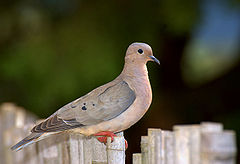|
Zenaida (gołębie)
| Zenaida[1]
|
| Bonaparte, 1838[2]
|
|
|

Przedstawiciel rodzaju – gołębiak plamouchy (Z. auriculata)
|
| Systematyka
|
| Domena
|
eukarionty
|
| Królestwo
|
zwierzęta
|
| Typ
|
strunowce
|
| Podtyp
|
kręgowce
|
| Gromada
|
ptaki
|
| Podgromada
|
Neornithes
|
| Infragromada
|
ptaki neognatyczne
|
| Rząd
|
gołębiowe
|
| Rodzina
|
gołębiowate
|
| Podrodzina
|
gołębie
|
| Rodzaj
|
Zenaida
|
| Typ nomenklatoryczny
|
|
Zenaida amabilis Bonaparte, 1838 (= Columba zenaida Bonaparte, 1825[a])
|
| Synonimy
|
- Zeneida Tschudi, 1846[3]
- Zonaida Reichenbach, 1849[4]
- Zenaidura Bonaparte, 1854[5]
- Melopelia Bonaparte, 1855[6]
- Zenoida Des Murs, 1856[7]
- Perissura Cabanis, 1856[8]
- Melopeleia Reichenbach, 1861[9]
- Platypteroena Reichenbach, 1861[10]
- Stenuroena Reichenbach, 1861[10]
- Zenaeda Coues, 1872[11]
- Zenaedura Coues, 1872[11]
- Nesopelia Sundevall, 1873[12]
|
|
| Gatunki
|
|
|
|
|
|
|
Zenaida – rodzaj ptaków z podrodziny gołębi (Columbinae) w rodzinie gołębiowatych (Columbidae).
Zasięg występowania
Rodzaj obejmuje gatunki występujące w Ameryce[13].
Morfologia
Długość ciała 18–34 cm; masa ciała 67–216 g[14].
Systematyka
Etymologia
- Zenaida (Zeneida, Zonaida, Zenoida, Zenaeda): epitet gatunkowy Columba zenaida Bonaparte, 1825 (Zenaida Letycja Julia Bonaparte, księżna Canino i Musignano (1804–1854), infantka Hiszpanii, kuzynka i żona francuskiego ornitologa, księcia Karola Lucjana Bonaparte)[15].
- Zenaidura (Zenaedura): rodzaj Zenaida Bonaparte, 1838; gr. ουρα oura „ogon”[16]. Gatunek typowy: Columba carolinensis Linnaeus, 1766[b]
- Melopelia (Melopeleia): gr. μελος melos „śpiew”; πελεια peleia „gołąb”[17]. Gatunek typowy: Columba leucoptera Linnaeus, 1758 (= Columba asiatica Linnaeus, 1758).
- Perissura: gr. περισσος perissos „znakomity”; ουρα oura „ogon”[18]. Gatunek typowy: Columba carolinensis Linnaeus, 1766[b]; nowa nazwa dla Zenaida Bonaparte, 1838.
- Platypteroena: gr. πλατυς platus „szeroki, otwarty”; πτερον pteron „pióro”; οινας oinas, οιναδος oinados „gołąb”[19]. Gatunek typowy: Zenaida pentheria Bonaparte, 1855[c].
- Stenuroena: gr. στηνος stēnos „wąski, cienki”; ουρα oura „ogon”; οινας oinas, οιναδος oinados „gołąb”[20]. Gatunek typowy: Zenaida stenura Bonaparte, 1855[c].
- Nesopelia: gr. νησος nēsos „wyspa” (tj. Galapagos); πελεια peleia „gołąb”[21]. Gatunek typowy: Zenaida galapagoensis Gould, 1841.
Podział systematyczny
Do rodzaju należą następujące gatunki[22]:
Uwagi
- ↑ Podgatunek Z. aurita.
- ↑ a b Podgatunek Z. macroura.
- ↑ a b Podgatunek Z. auriculata.
Przypisy
- ↑ Zenaida, [w:] Integrated Taxonomic Information System (ang.).
- ↑ Ch.-L. Bonaparte: A geographical and comparative list of the birds of Europe and North America. London: J. Van Voorst, 1838, s. 41. (ang.).
- ↑ J.J. von Tschudi: Untersuchungen über die Fauna Peruana. St. Gallen: Druck und verlag von Scheitlin und Zollikofer, 1844–1846, s. 45. (niem.).
- ↑ H.G.L. Reichenbach: Avium systema naturale. Das natürliche system der vögel mit hundert tafeln grösstentheils original-abbildungen der bis jetzt entdecken fast zwölfhundert typischen formen. Vorlaüfer einer iconographie der arten der vögel aller welttheile. Dresden und Leipzig: Expedition der vollständigsten naturgeschichte, 1850, s. ryc. xxiii. (niem.).
- ↑ Ch.-L. Bonaparte. Coup d’œil sur l’ordre des Pigeons. „Comptes rendus hebdomadaires des Séances de l’Académie des Sciences”. 39, s. 871, 1854. (fr.).
- ↑ Ch.-L. Bonaparte. Coup d’œil sur les Pigeons (cinquième partie). „Comptes rendus hebdomadaires des Séances de l’Académie des Sciences”. 40, s. 98, 1855. (fr.).
- ↑ M.A.P.O. Des Murs: Quatrième ordre. – Pigeons. W: J.Ch. Chenu: Encyclopédie d’histoire naturelle; ou, traité complet de cette science d’après les travaux des naturalistes les plus éminents de tous les pays et de toutes les époques: Buffon, Daubenton, Lacépède, G. Cuvier, F. Cuvier, Geoffroy Saint-Hilaire, Latreille, De Jussieu, Brongniart, etc.. Cz. 6: Oiseaux. Paris: Maresq, 1856, s. 49. (fr.).
- ↑ J. Cabanis. Dr. J. Gundlach’s Beitrage zur Ornithologie Cuba’s. „Journal für Ornithologie”. 4, s. 111, 1856. (niem.).
- ↑ Reichenbach 1862 ↓, s. 22.
- ↑ a b Reichenbach 1862 ↓, s. 20.
- ↑ a b E. Coues: Key to North American birds. Salem: Naturalists’ Agency, 1872, s. 226. (ang.).
- ↑ C.J. Sundevall: Methodi naturalis avium disponendarum tentamen: försök till fogelklassens naturenliga uppställnung. Stockholm: Samson & Wallin, 1872, s. 99. (łac.).
- ↑ F. Gill, D. Donsker & P. Rasmussen (red.): Pigeons. IOC World Bird List (v10.2). [dostęp 2020-08-08]. (ang.).
- ↑ L.F. Baptista, P.W. Trail & H.M. Horblit: Family Columbidae (Pigeons and Doves). W: J. del Hoyo, A. Elliott & J. Sargatal: Handbook of the Birds of the World. Cz. 4: Sandgrouse to Cuckoos. Barcelona: Lynx Edicions, 1997, s. 158–161. ISBN 84-87334-22-9. (ang.).
- ↑ The Key to Scientific Names ↓, Zenaida [dostęp 2018-09-30] .
- ↑ The Key to Scientific Names ↓, Zenaidura [dostęp 2018-09-30] .
- ↑ The Key to Scientific Names ↓, Melopelia [dostęp 2018-09-30] .
- ↑ The Key to Scientific Names ↓, Perissura [dostęp 2018-09-30] .
- ↑ The Key to Scientific Names ↓, Platypteroena [dostęp 2018-09-30] .
- ↑ The Key to Scientific Names ↓, Stenuroena [dostęp 2018-09-30] .
- ↑ The Key to Scientific Names ↓, Nesopelia [dostęp 2018-09-30] .
- ↑ Systematyka i nazwy polskie za: P. Mielczarek & M. Kuziemko: Podrodzina: Columbinae Leach, 1820 – gołębie (wersja: 2019-07-21). [w:] Kompletna lista ptaków świata [on-line]. Instytut Nauk o Środowisku Uniwersytetu Jagiellońskiego. [dostęp 2020-08-08].
Bibliografia
- The Key to Scientific Names, J.A.J.A. Jobling (red.), [w:] Birds of the World, S.M. Billerman et al. (red.), Cornell Lab of Ornithology, Ithaca (ang.).
- H.G.L. Reichenbach: Handbuch der speciellen Ornithologie. Cz. 2: Columbariae: Megapodinae, Peristerinae, Columbinae, Alectorinae. Dresden und Leipzig: Expedition der Vollständigsten Naturgeschichte, 1862. (niem.).
Identyfikatory zewnętrzne:
|
|